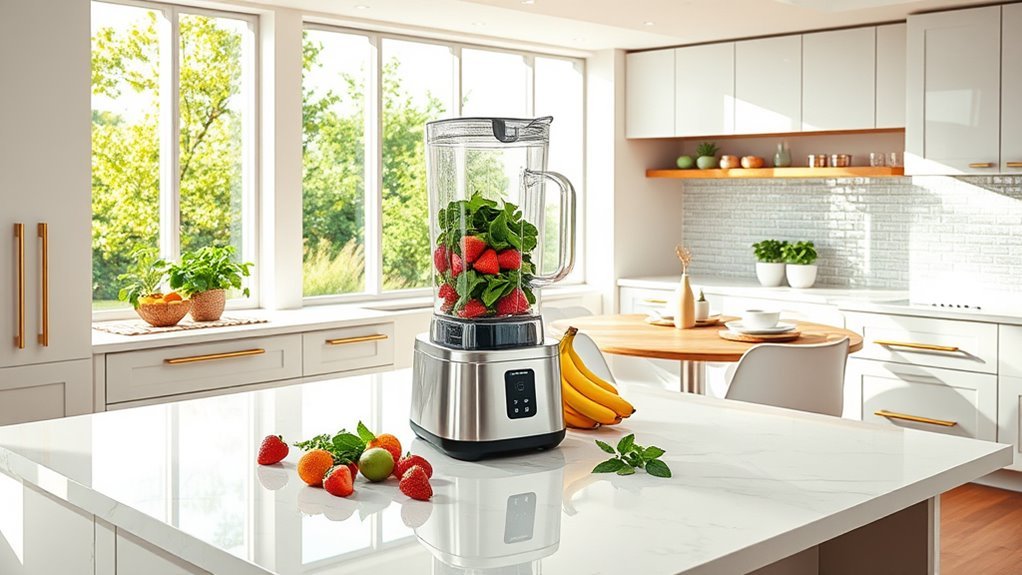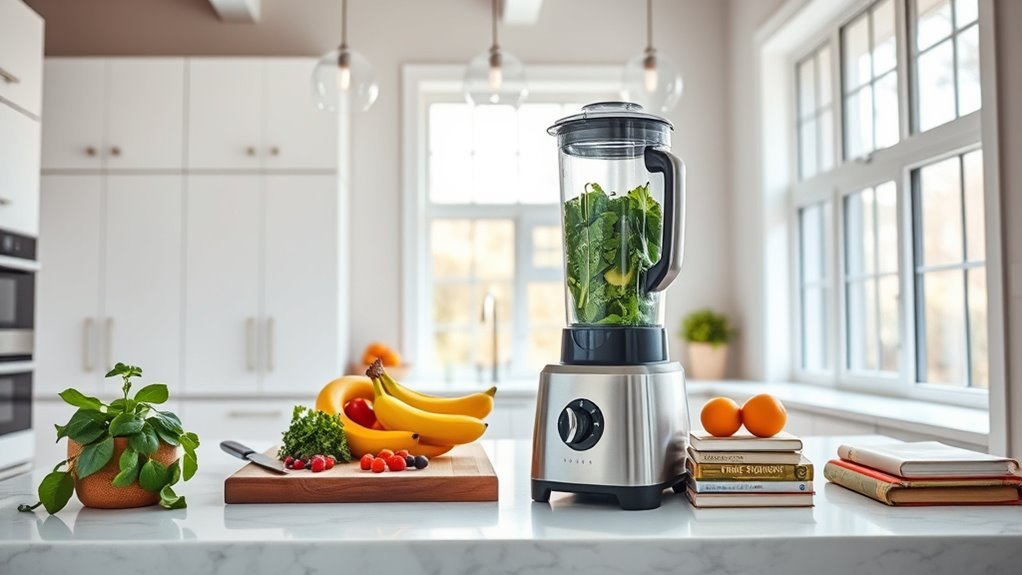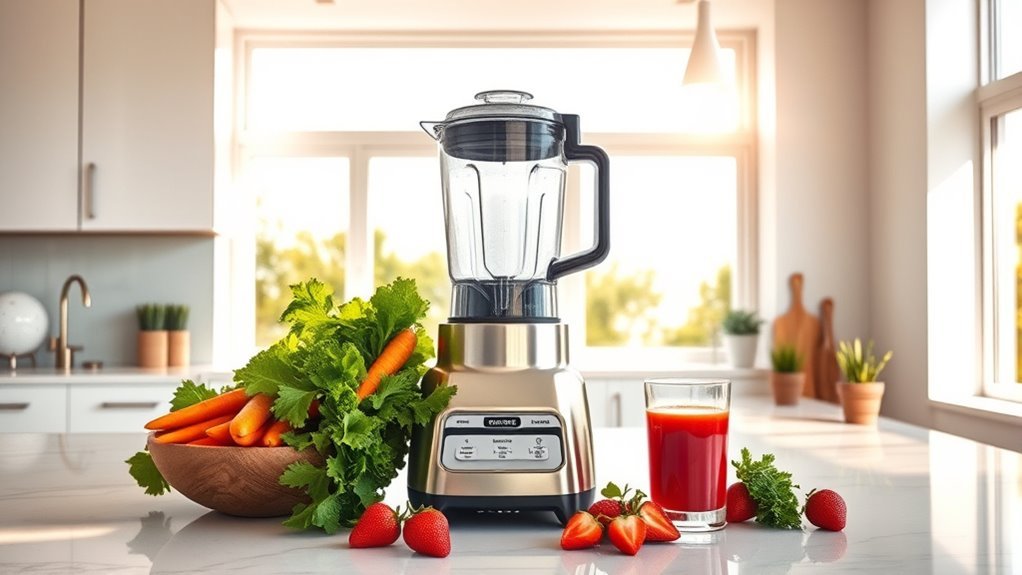We recommend multi-pronged blades made from high-carbon stainless steel for professional blending power. The sweet spot? Blades around 3mm thick with balanced sharp edges and blunt tips – perfect for crushing ice and frozen fruit while maintaining durability. Regular cleaning and monthly sharpness checks keep performance peak, while specialized configurations like wingtip blades handle thick blends without a tamper. There’s more to maximizing your blender’s potential than meets the eye.
Essential Blade Designs for Commercial Blending

Three key blade designs dominate the commercial blending landscape, each engineered for specific culinary demands.
We’ve found that multi-pronged configurations deliver superior blending efficiency by creating powerful vortexes that’ll transform your ingredients into perfectly processed results.
Let’s talk materials: stainless steel and hardened alloys aren’t just fancy terms – they’re essential for durability in demanding commercial environments.
High-performance blenders shine with specialized designs like the WildSide+ jar, maximizing ingredient circulation for consistent results. Whether you’re ice crushing or emulsifying, the blade angle matters.
Smart operators know that replaceable blade assemblies are worth their weight in gold.
They’ll extend your blender’s life and keep maintenance costs down. It’s not just about power – it’s about precision engineering that delivers professional results every time. Additionally, investing in a high-performance blender can enhance your blending capabilities and provide smoother textures.
Material Construction and Durability Standards
When durability meets precision engineering, high-carbon stainless steel emerges as the gold standard for commercial blender blades.
We’re talking about blade design that’s built to last, featuring a perfect balance of sharp edges and blunt tips for maximum cutting efficiency.
You’ll find these commercial models sporting hardened steel construction – it’s what keeps them sharp through countless blending sessions.
We’ve seen thicker blades, up to 3mm, handle everything from ice to frozen fruit without flinching. That’s the kind of durability standards we demand in professional kitchens.
Pair these robust blades with precision-engineered motors, and you’ve got a combination that’s unstoppable for long-term use. Moreover, the motor power in high-performance blenders ranges from 1,000 to 1,500 watts, ensuring optimal performance and efficiency in any commercial setting.
It’s simple: better materials mean better performance, and that’s exactly what you need in a commercial environment.
Optimizing Blade Performance and Longevity

To maximize your commercial blender’s performance, proper blade maintenance isn’t just recommended – it’s crucial.
We’ve found that high-quality stainless steel blades deliver professional-quality results, but only when properly maintained and operated.
- Clean blades thoroughly after each use – trapped particles accelerate wear and compromise blending efficiency
- Monitor speed settings carefully – match them to your ingredients to preserve blade integrity
- Check blade sharpness monthly – dull blades strain motors and produce inferior results
- Consider models with replaceable blades – they’re cost-effective and guarantee consistent performance
Specialized Blade Configurations for Different Tasks
Different blending tasks demand specialized blade configurations that can make or break your results.
Let’s explore how these designs tackle specific challenges.
High-powered blenders with multiple angled blades create a powerful vortex that’s essential for consistent blending results.
We’re particularly impressed by innovations like the single-prong tuned wingtip blade, which handles thick blends without needing a tamper.
For larger batches, we’ll opt for 5-sided jar designs that optimize ingredient circulation.
When we’re emulsifying ingredients for smooth sauces, blunt blades often outperform complex configurations.
And don’t overlook specialized frothing blades – they’re your secret weapon for perfectly aerated milk in lattes.
Each blade design serves a distinct purpose, maximizing cutting efficiency for professional-quality results every time.
Safety Features and Maintenance Requirements

Since safety features and maintenance routines go hand-in-hand, we’ll tackle both aspects head-on.
Professional-grade blenders demand rigorous attention to both safety mechanisms and regular maintenance to guarantee peak blending performance.
- Automatic braking and sound enclosures aren’t just fancy features – they’re critical operator safety components that protect you during high-volume operations.
- Tool-free disassembly makes daily cleaning a breeze, while specialized cleaning accessories like the Rapid Rinse™ Station keep your blender jar spotless.
- Regular blade inspection prevents motor strain and maintains peak performance – don’t wait for dull blades to wreck your warranty.
- Most professional units include extensive warranty coverage (typically 3-4 years), but only if you maintain them properly.
Trust us – skip the maintenance, and you’ll regret it.
These machines are investments worth protecting.
Frequently Asked Questions
What Blenders Do Professional Chefs Use?
Prithee, we’ll tell you professional chefs favor powerful machines like Vitamix A3500 and Blendtec Total Blender, with high motor power and expert blending techniques ensuring smooth consistency in every professional kitchen.
Who Makes the Best Blender on the Market?
We’ve found Vitamix consistently outperforms competitors like Blendtec and Breville, offering superior durability and warranty coverage. While pricier than Ninja or KitchenAid options, their high-speed performance justifies the investment.
What Is the Difference Between Commercial and Professional Blenders?
Like day and night, commercial and professional blenders differ in their muscle. We’ll find commercial models pack more power, durability, and higher usage rates, while professional ones balance home-friendly features with moderate performance.
How Many Watts Should a Commercial Blender Have?
We recommend commercial blenders with at least 1,500 watts for best blending performance, though 1,800-2,000 watts is ideal for heavy-duty applications, ensuring better motor efficiency and durability for professional smoothie-making and ice crushing.

